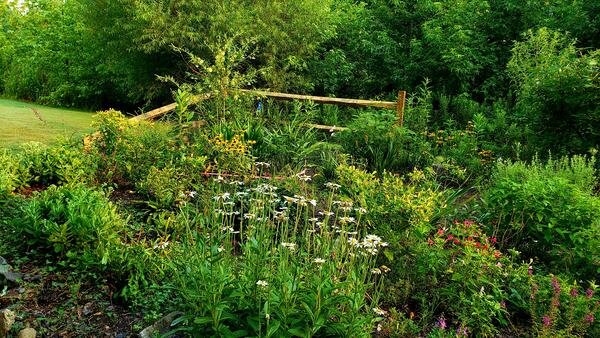By Jay Keck, SCWF Habitat Education Manager
Published 9/24/21 in Chapin Magazine
Everyone knows the phrase. Say it with me: “The only good snake is…a dead snake.” Yikes! That’s a little aggressive, don’t you think? –Especially when snakes are such an important part of our ecosystem and provide so much food for wildlife, as well as services to help keep us healthy and free of some diseases. I’ve heard that phrase my entire life, and until recently, I never really thought about why people say it. But then, like many other Americans, I saw episode 8 of the best show known to man, Ted Lasso (season 1) where he talked about curiosity, or the lack thereof, and applied it to our general dislike – or is it fear?– of snakes. So, if you’ll please keep reading, we will tap into your wonderfully curious mind and learn about some of the amazing and beautiful snakes found in Chapin. And maybe, just maybe, you’ll find yourself creating habitat not just for birds and butterflies, but also for our appendageless beauties!
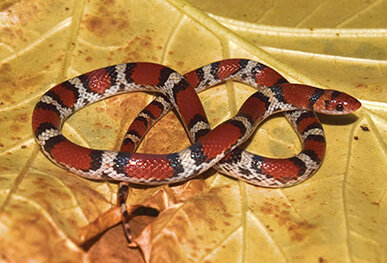
Scarlet Snake – Photo by Parker Gibbons
I understand the fear. One of my favorite comics growing up was Garfield, and I really liked the ones in which he would squish spiders. He was really creative with it too, but a rolled-up newspaper was his go-to weapon against those evil eight-legged creatures. I related; and if memory serves me correctly, my weapon of choice against spiders in my youth was a magazine. I still use a magazine, but after my love affair with the planet began about 10 years ago, I now use it as a catch-and-release tool so that the spider can play out its role in the ecosystem within my family’s property. I can even catch jumping spiders with my hands now, but I’ll save that for a different article. My change in behavior began with curiosity, then education, followed by the application of the knowledge, which I believe is a pretty good formula for overcoming a fear.
So let’s try and quell some of that snake fear by introducing you to some of our smallest, most common, and beautiful non-venomous snakes in our area. Red-bellied snakes are tiny and range in size from 4-10 inches long. The color on the back of the snake has a tremendous amount of variation and can be brown, reddish, or charcoal, with a bright orange or red belly. These snakes can be found under logs, rocks, and in the leaf litter, and mainly eat slugs. Did you hear that gardeners? They eat slugs! We should welcome this beautiful snake to our vegetable gardens! Other small brown snakes include Worm snakes, Earth snakes, and Brown snakes, with Brown snakes sometimes being confused with the Garter snake; one of the more common and well-known snakes in the area, that could be described as – dare I say – pretty. Another tiny (10-15 inches) and stunning snake in Chapin is the Ringneck snake. Unfortunately, for those who would like to see them, they are another species of snake that likes to stay hidden in debris, under logs, or in leaf litter, though occasionally you’ll find one traveling in the open for a brief period of time. If I still haven’t convinced you that snakes are beautiful, please focus your attention to the Scarlet snake, one of our three tri-colored snakes of SC, that sports a bright red, black, and white or yellow coloration. This small snake (20 inches) is another fossorial snake you’ll most likely not encounter unless you actively look for it under logs, rocks, or other debris.
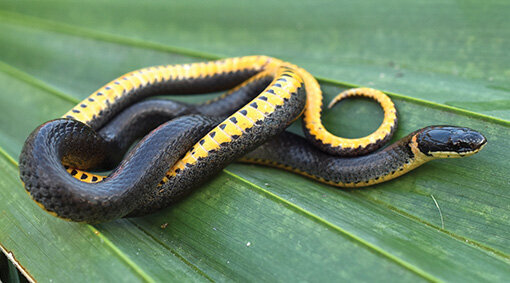
Ringneck Snake photo by Parker Gibbons
Since we’re moving from smallest to largest, at this point we stop measuring snakes in inches and increase the unit of measurement to feet. One of the most abundant and visible non-venomous snakes in Chapin also happens to be one of our largest snakes; the Eastern rat snake whose color changes from region to region. In the Piedmont, it’s typically black, but its color lightens to a grayish color below SC’s Fall Line, and can even appear greenish-yellow with stripes in the coastal plain, especially along the outer edge of the coastal plain. These snakes are typically 3-5 feet long, but can reach lengths to over 6 feet! Their diet consists of mice, lizards, rats, squirrels, birds, and even bird eggs, but before you get upset about the last part, go look in your refrigerator and count how many dozen eggs you have. We currently have 2 dozen eggs in ours. We’re predators. Snakes are predators. We both enjoy eggs… These snakes are excellent climbers and are shaped like a loaf of bread, with a flat belly and rounded back, which gives them the ability to climb walls, poles, and trees! Often, when I think about snakes controlling diseases, I think about the Eastern rat snake and how many small mammals they consume. Many of those mammals carry ticks, and ticks can carry Lyme disease. Recent studies have shown that some snakes consume thousands of ticks each year from the mammals they eat. Eastern rat snake – take a bow.
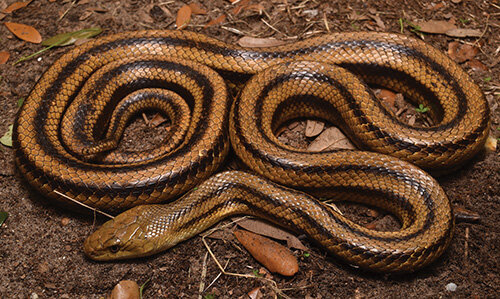
Yellow Rat Snake photo by Parker Gibbons

Eastern King Snake photo by Parker Gibbons
Other snakes are known as ophiophagic (fancy science word,) meaning they eat other snakes. Eastern kingsnakes, Black racers, and Indigo snakes are some of the species in the southeast that frequently eat other snake species. The Eastern kingsnake is a large (up to 4 feet) gorgeous black snake with white to yellow chain-link bands along its back. They are resistant to pit-viper venom and will eat Copperheads, Cottonmouths, and Rattlesnakes. If you think venomous snakes are “bad” then think of the Eastern kingsnake as being the personal snake version of General Patton. Another long black snake in our area is the Black racer, a slender species that will also eat other snakes, even venomous species, as well as lizards, frogs, birds, and other prey items. When approached Black racers tend to flee quickly, rather than freeze, as the Eastern rat snake and kingsnake will do. Finally, a large snake that I must mention is the Corn snake, or red rat snake, simply for its sheer beauty. I’ve seen people react to this snake with wonder and awe as a direct result of its gorgeous markings and coloration. Unfortunately, many people mistakenly identify this species and kill it because they think it is a Copperhead, which is frustrating for many different reasons.
Copperheads are venomous and need to be respected. They are also beautifully colored and serve a purpose in our ecosystem. They can be dangerous, but if you’d like to investigate SC and U.S. injury statistics in more depth, a quick Google search or two could reveal how little we have to worry about these snakes, though we should still be careful and responsible as outdoorsman and gardeners. All snakes, whether they are venomous or non-venomous, serve a purpose. They are food for insects, birds, frogs, lizards, and many mammals. Even our beloved Eastern Bluebird enjoys a nice snake snack from time to time. Think about that the next time you see a snake in your garden. Instead of wasting that snake’s life, let it live and play out its important role within our planet. Respect it and think about how its life is connected to the world around it. Become comfortable with it and you may find yourself wanting to create habitat to support it. All life, not just the birds and butterflies, deserve a place in the wild beyond your window. My hope is that you show respect to all wildlife, even the wildlife you may not completely understand – the animals you may fear – and find a connection and love for them.

Copperhead photo by Parker Gibbons
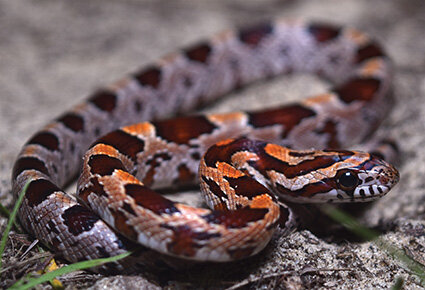
Baby Corn Snake photo by Parker Gibbons
Resources for Future Learning:
Book: Snakes of the Southeast by Whit Gibbons and Mike Dorcas
Website: Savannah River Ecology Laboratory
Three SC snake-focused Instagram accounts:
Published 9/24/21 in Chapin Magazine






